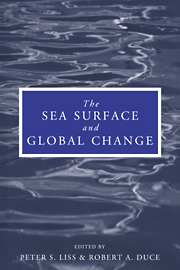Book contents
- Frontmatter
- Contents
- List of contributors
- Preface
- 1 Report Group 1 – Physical processes in the microlayer and the air–sea exchange of trace gases
- 2 Report Group 2 – Biological effects of chemical and radiative change in the sea surface
- 3 Report Group 3 – Photochemistry in the sea-surface microlayer
- 4 Transport processes in the sea-surface microlayer
- 5 The role of organic films in air–sea gas exchange
- 6 Bubbles and their role in gas exchange
- 7 The physical chemistry of air–sea gas exchange
- 8 The sea-surface microlayer and its effect on global air–sea gas transfer
- 9 Chemistry of the sea-surface microlayer
- 10 Biophysics of the surface film of aquatic ecosystems
- 11 Biological effects of chemicals in the sea-surface microlayer
- 12 Neuston of seas and oceans
- 13 Photochemistry in the sea-surface microlayer
- 14 Hydrocarbon breakdown in the sea-surface microlayer
- 15 Applications of laser technology and laser spectroscopy in studies of the ocean microlayer
- 16 Remote sensing of the sea-surface microlayer
- Index
4 - Transport processes in the sea-surface microlayer
Published online by Cambridge University Press: 24 September 2009
- Frontmatter
- Contents
- List of contributors
- Preface
- 1 Report Group 1 – Physical processes in the microlayer and the air–sea exchange of trace gases
- 2 Report Group 2 – Biological effects of chemical and radiative change in the sea surface
- 3 Report Group 3 – Photochemistry in the sea-surface microlayer
- 4 Transport processes in the sea-surface microlayer
- 5 The role of organic films in air–sea gas exchange
- 6 Bubbles and their role in gas exchange
- 7 The physical chemistry of air–sea gas exchange
- 8 The sea-surface microlayer and its effect on global air–sea gas transfer
- 9 Chemistry of the sea-surface microlayer
- 10 Biophysics of the surface film of aquatic ecosystems
- 11 Biological effects of chemicals in the sea-surface microlayer
- 12 Neuston of seas and oceans
- 13 Photochemistry in the sea-surface microlayer
- 14 Hydrocarbon breakdown in the sea-surface microlayer
- 15 Applications of laser technology and laser spectroscopy in studies of the ocean microlayer
- 16 Remote sensing of the sea-surface microlayer
- Index
Summary
Abstract
The gas flux of weakly soluble gases through the air–sea interface is controlled by the transport mechanism in the aqueous diffusive boundary layer. The combination of molecular and turbulent transport and of secondary motions near the interface determines the exchange rate. This layer is difficult to access experimentally, so a combination of observation and physical interpretation is necessary.
Typical modes of fluid motion at the interface and their potential to further gas exchange are reviewed: organized motions, like cell and helicoidal rolls or Langmuir circulation on one hand, waves and wind induced shear flow on the other. Special attention is given to wave dissipation in the form of wave breaking. The secondary flow and irregular motions of breaking waves, as well as possible rolling motions of smaller waves on the slopes of larger waves, are seen as enhancing gas transfer through surface renewal.
Observations of surface streaming obtained by dying the sea surface are discussed in terms of the above-mentioned models of surface renewal. A set of observations by Gemmrich is used to assess the effectiveness of secondary motions, as found at a given wind speed at sea, to enhance gas transfer. It is found for the natural mix of wind speeds (e.g. for the North Atlantic Ocean) that enhancement of gas transfer, compared with undisturbed boundary-layer flow, occurs in about 20–25% of cases.
- Type
- Chapter
- Information
- The Sea Surface and Global Change , pp. 93 - 120Publisher: Cambridge University PressPrint publication year: 1997
- 2
- Cited by



